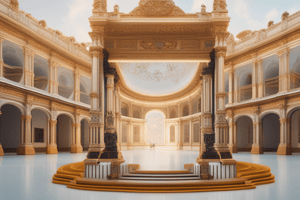Podcast
Questions and Answers
Which artistic period was known for its emotionally charged compositions and theatricality?
Which artistic period was known for its emotionally charged compositions and theatricality?
- Baroque (correct)
- Renaissance
- Neoclassicism
- Romanticism
During the Renaissance, which artistic concept involved the depiction of the human potential and secular subjects?
During the Renaissance, which artistic concept involved the depiction of the human potential and secular subjects?
- Patronage
- Chiaroscuro
- Rococo
- Humanism (correct)
In which art movement were themes of elegance, frivolity, and decorative excess prominent, with pastel colors and delicate forms?
In which art movement were themes of elegance, frivolity, and decorative excess prominent, with pastel colors and delicate forms?
- Baroque
- Humanism
- Neoclassicism
- Rococo (correct)
Which artistic period was characterized by an inspiration drawn from classical Greek and Roman art, featuring themes of heroism and virtue?
Which artistic period was characterized by an inspiration drawn from classical Greek and Roman art, featuring themes of heroism and virtue?
Which art movement emphasized emotion, imagination, and individual expression, rejecting strict rules and conventions?
Which art movement emphasized emotion, imagination, and individual expression, rejecting strict rules and conventions?
Which artistic period associated with aristocratic culture features themes of love, romance, and nature?
Which artistic period associated with aristocratic culture features themes of love, romance, and nature?
Which art movement emphasized capturing fleeting moments and effects of light?
Which art movement emphasized capturing fleeting moments and effects of light?
Who were the key artists associated with Post-Impressionism?
Who were the key artists associated with Post-Impressionism?
Which movement is known for the deconstruction of objects into geometric shapes?
Which movement is known for the deconstruction of objects into geometric shapes?
In which style of Cubism did artists use collage and mixed media?
In which style of Cubism did artists use collage and mixed media?
Which characteristic is associated with Post-Impressionism?
Which characteristic is associated with Post-Impressionism?
Study Notes
Renaissance (14th - 17th century)
- Revival of classical Greek and Roman ideals
- Emergence of Humanism, emphasizing individualism, human potential, and secular subjects
- Artistic innovations: Realism and perspective
- Patrons: Wealthy families and the Catholic Church
- Notable artists: Leonardo da Vinci, Michelangelo, Raphael
Baroque (17th - 18th century)
- Dramatic use of light and shadow (chiaroscuro)
- Emotionally charged compositions with intense spirituality
- Ornate decoration and grandeur
- Themes: Religious and intensely spiritual
- Notable artists: Caravaggio, Bernini, Rembrandt
Rococo (18th century)
- Characterized by elegance, frivolity, and decorative excess
- Pastel colors, delicate forms, and asymmetrical compositions
- Themes: Love, romance, and nature
- Associated with aristocratic and courtly culture
- Notable artists: Jean-Antoine Watteau, François Boucher
Neoclassicism (18th - 19th century)
- Inspired by classical Greek and Roman art and ideals
- Emphasis on rationality, order, and moral virtue
- Simple, symmetrical compositions and clear outlines
- Themes: Heroism, patriotism, and virtue
- Notable artists: Jacques-Louis David, Antonio Canova
Romanticism (late 18th - mid-19th century)
- Emphasis on emotion, imagination, and individual expression
- Appreciation for nature, the sublime, and the exotic
- Rejection of strict rules and conventions
- Interest in folk culture, medievalism, and the supernatural
- Notable artists: J.M.W.Turner, Eugène Delacroix, Caspar David Friedrich
Impressionism (late 19th century)
- Emphasis on capturing fleeting moments and effects of light
- Loose brushwork and visible brushstrokes
- Interest in everyday subjects and outdoor scenes
- Use of complementary colors and broken color
- Notable artists: Claude Monet, Pierre-Auguste Renoir, Edgar Degas
Post-Impressionism (late 19th - early 20th century)
- Exploration of subjective emotion and symbolism
- Experimentation with color and form
- Interest in structure and composition
- Diverse styles, including Pointillism, Synthetism, and Cloisonnism
- Notable artists: Vincent van Gogh, Paul Cézanne, Georges Seurat
Cubism (early 20th century)
- Fragmentation and abstraction of form
- Depiction of multiple viewpoints simultaneously
- Analytical Cubism: Deconstruction of objects into geometric shapes
- Synthetic Cubism: Use of collage and mixed media
- Notable artists: Pablo Picasso, Georges Braque, Juan Gris
Studying That Suits You
Use AI to generate personalized quizzes and flashcards to suit your learning preferences.
Description
Test your knowledge on the characteristics, key artists, and themes of Renaissance and Baroque art movements from the 14th to 18th century. Explore the revival of classical ideals, humanism, realism, perspective in art, and the dramatic use of light and shadow in Baroque art.




